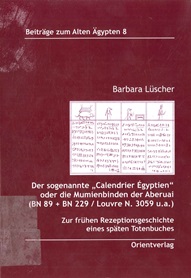| Main » Ad Board » ДРЕВЕН ЕГИПЕТ И АФРИКА » Литература |
| 14.05.2022, 06:22 | |
Първо научно издание на един писмен паметник с наистина куриозна история. Книгата на мъртвите, принадлежала на живялата през епохата на Птолемеите (305-31 г. пр. н.е.) дама на име Аберуаи е изписана с късно йератическо писмо върху превръзките, с които е обвита нейната мумия. През 1698 след като е току що открита, тези превръзки са снети в присъствието на тогавашния френски консул Франсоа дьо Майе и са нарязани на късове, разделени между присъстващите. Дълго време преди разчитането на древноегипетската писменост паметникът е считан за древноегипетски календар, като е отбелязван така в различни публикации на проучвания от онази епоха. Въпреки недоразумението, той оказва значимо влияние при възраждането на интереса към египетската древност и за разчитането на йератическото писмо. - на древноегипетски език (йератическо писмо) и немски език, от MEGA, формат PDF.Сваляне с ляв бутон (downloading by left button) и после през бутона Download. АЛТЕРНАТИВЕН ЛИНК / ALTERNATIVE LINK: - на древноегипетски език (йератическо писмо) и немски език от Google Drive, формат PDF. Сваляне с ляв бутон (downloading by left button) от страницата на предоставящия сървър, после през бутона стрелка надолу/after by down arrow button.
| |
| Views: 546 | Placed till: 14.06.2022 | Rating: 0.0/0 | |

